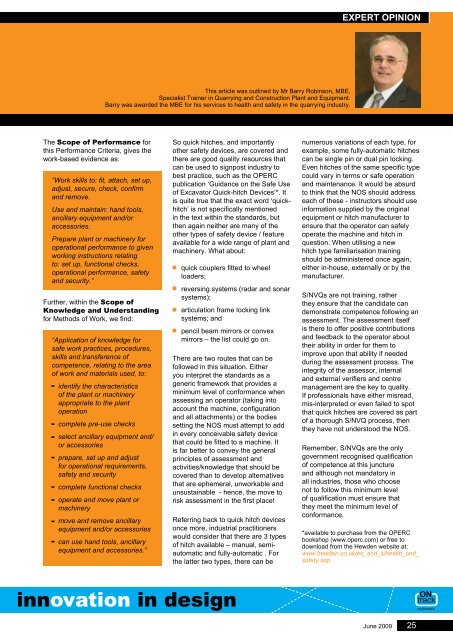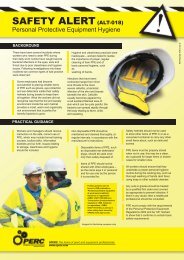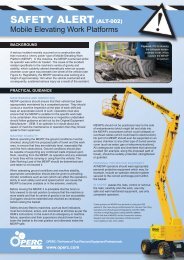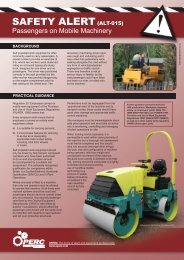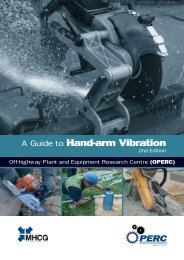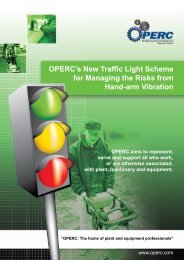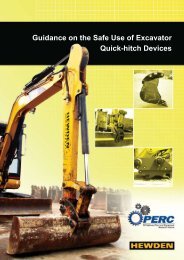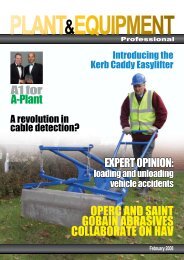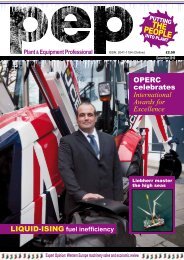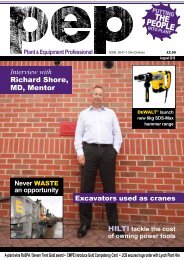Download pdf - OPERC
Download pdf - OPERC
Download pdf - OPERC
- No tags were found...
You also want an ePaper? Increase the reach of your titles
YUMPU automatically turns print PDFs into web optimized ePapers that Google loves.
expert Opinion<br />
This article was outlined by Mr Barry Robinson, MBE,<br />
Specialist Trainer in Quarrying and Construction Plant and Equipment.<br />
Barry was awarded the MBE for his services to health and safety in the quarrying industry.<br />
The Scope of Performance for<br />
this Performance Criteria, gives the<br />
work-based evidence as:<br />
“Work skills to: fit, attach, set up,<br />
adjust, secure, check, confirm<br />
and remove.<br />
Use and maintain: hand tools,<br />
ancillary equipment and/or<br />
accessories.<br />
Prepare plant or machinery for<br />
operational performance to given<br />
working instructions relating<br />
to: set up, functional checks,<br />
operational performance, safety<br />
and security.”<br />
Further, within the Scope of<br />
Knowledge and Understanding<br />
for Methods of Work, we find:<br />
“Application of knowledge for<br />
safe work practices, procedures,<br />
skills and transference of<br />
competence, relating to the area<br />
of work and materials used, to:<br />
identify the characteristics<br />
of the plant or machinery<br />
appropriate to the plant<br />
operation<br />
complete pre-use checks<br />
select ancillary equipment and/<br />
or accessories<br />
prepare, set up and adjust<br />
for operational requirements,<br />
safety and security<br />
complete functional checks<br />
operate and move plant or<br />
machinery<br />
move and remove ancillary<br />
equipment and/or accessories<br />
can use hand tools, ancillary<br />
equipment and accessories.”<br />
So quick hitches, and importantly<br />
other safety devices, are covered and<br />
there are good quality resources that<br />
can be used to signpost industry to<br />
best practice, such as the <strong>OPERC</strong><br />
publication ‘Guidance on the Safe Use<br />
of Excavator Quick-hitch Devices’*. It<br />
is quite true that the exact word ‘quickhitch’<br />
is not specifically mentioned<br />
in the text within the standards, but<br />
then again neither are many of the<br />
other types of safety device / feature<br />
available for a wide range of plant and<br />
machinery. What about:<br />
quick couplers fitted to wheel<br />
loaders;<br />
reversing systems (radar and sonar<br />
systems);<br />
articulation frame locking link<br />
systems; and<br />
pencil beam mirrors or convex<br />
mirrors – the list could go on.<br />
There are two routes that can be<br />
followed in this situation. Either<br />
you interpret the standards as a<br />
generic framework that provides a<br />
minimum level of conformance when<br />
assessing an operator (taking into<br />
account the machine, configuration<br />
and all attachments) or the bodies<br />
setting the NOS must attempt to add<br />
in every conceivable safety device<br />
that could be fitted to a machine. It<br />
is far better to convey the general<br />
principles of assessment and<br />
activities/knowledge that should be<br />
covered than to develop alternatives<br />
that are ephemeral, unworkable and<br />
unsustainable - hence, the move to<br />
risk assessment in the first place!<br />
Referring back to quick hitch devices<br />
once more, industrial practitioners<br />
would consider that there are 3 types<br />
of hitch available – manual, semiautomatic<br />
and fully-automatic . For<br />
the latter two types, there can be<br />
numerous variations of each type, for<br />
example, some fully-automatic hitches<br />
can be single pin or dual pin locking.<br />
Even hitches of the same specific type<br />
could vary in terms or safe operation<br />
and maintenance. It would be absurd<br />
to think that the NOS should address<br />
each of these - instructors should use<br />
information supplied by the original<br />
equipment or hitch manufacturer to<br />
ensure that the operator can safely<br />
operate the machine and hitch in<br />
question. When utilising a new<br />
hitch type familiarisation training<br />
should be administered once again,<br />
either in-house, externally or by the<br />
manufacturer.<br />
S/NVQs are not training, rather<br />
they ensure that the candidate can<br />
demonstrate competence following an<br />
assessment. The assessment itself<br />
is there to offer positive contributions<br />
and feedback to the operator about<br />
their ability in order for them to<br />
improve upon that ability if needed<br />
during the assessment process. The<br />
integrity of the assessor, internal<br />
and external verifiers and centre<br />
management are the key to quality.<br />
If professionals have either misread,<br />
mis-interpreted or even failed to spot<br />
that quick hitches are covered as part<br />
of a thorough S/NVQ process, then<br />
they have not understood the NOS.<br />
Remember, S/NVQs are the only<br />
government recognised qualification<br />
of competence at this juncture<br />
and although not mandatory in<br />
all industries, those who choose<br />
not to follow this minimum level<br />
of qualification must ensure that<br />
they meet the minimum level of<br />
conformance.<br />
*available to purchase from the <strong>OPERC</strong><br />
bookshop (www.operc.com) or free to<br />
download from the Hewden website at:<br />
www.hewden.co.uk/eh_and_s/health_and_<br />
safety.asp.<br />
innovation in design<br />
innovation in design<br />
June 2009<br />
25


